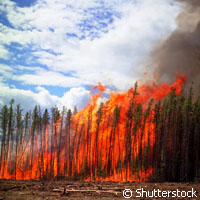The red-hot art of forest fire management
Trees ablaze, frantic fleeing, thick smoke blocking out the sky ... a rampaging forest fire is a terrifying prospect. And yet, avoiding all forest fires at all times may simply increase the risk of bigger, less controllable fires further along the line. An EU-funded team of researchers has developed an integrated wildland fire management approach, which notably emphasises the scope to fight fire with fire. The FIRE PARADOX ('An innovative approach of integrated wildland fire management regulating the wildfire problem by the wise use of fire: solving the fire paradox') project received more than EUR 12.6 million under the 'Sustainable development, global change and ecosystems' Thematic area of the EU's Sixth Framework Programme (FP6). In a statement, FIRE PARADOX partner Cemagref (France) says: 'European forests are regularly attacked by fire with often disastrous environmental, economic and social consequences. The most common reaction has been to fight fires at all costs because the negative impacts have been the primary concern. But now, a new approach to territorial management and to fire prevention and fighting is indispensable if we are to sustainably attenuate the intensity and severity of fires in Europe.' '"Fire is a bad master, but a good servant",' says Cemagref, explaining the name. 'This Finnish expression sums up our paradoxical relation with fire. The paradox lies in the fact that by hindering forest fires at all costs, the potential damage of the next fire increases over time because the accumulation of plant biomass represents an increase in fuel that can cause and feed fires,' adds the group, a French public research institute specialising in environmental issues. Fighting fire with fire involves controlled burning, a method by which tightly delineated fires are started in order to reduce plant biomass preventively or as counter-fire tactics. Such techniques have been used throughout history and are now known to help reduce the total amount of carbon dioxide (CO2) generated by forest fires, but they require a detailed understanding of the way fires develop and spread. It is a case of 'learning to live with fire'. The FIRE PARADOX partners have delivered an extensive body of work drawing on specialist expertise, new knowledge and innovative approaches. Part of this work focused on the causes and dynamics of fire, with other strands dedicated to risk analyses and management methods. The project's findings have fuelled the development of a set of tools and applications specifically designed for fire and forestry professionals as well as territorial authorities. Examples of these applications feature a software simulator for large-scale fires in Europe and the wider Mediterranean area, a risk assessment and mapping method, and a range of publications. 'At Cemagref,' the institute remarks, outlining one of its contributions to the project, 'scientists have characterised the biological mechanisms governing flammability and combustibility of trees and plants. That information is used to develop methods to describe in detail the various plant species (bushes or trees, with or without branches, needles or leaves, etc.) and to rank stands according to their flammability and combustibility.' This work was carried out in cooperation with two other project partners in France: the National Institute for Agricultural Research (INRA) and Agence MTDA Sarl. The joint contribution fed into the development of the simulator, which analyses information on factors such as topography, wind and stand combustibility to predict how individual fires are likely to spread. The risk assessment method focuses on the so-called interface zones between areas dedicated to buildings or infrastructure and stretches of wildland, where human activity compounds the risk of fires. The risk to these areas varies depending on a range of factors, such as residential characteristics and the exact type and density of vegetation. The application combines spatial analysis and satellite imagery with information on past fires to provide risk indicators for these interface zones. The project's key publications include a handbook outlining sound practice in controlled burning and a methods guide on interface mapping in the Mediterranean region. FIRE PARADOX involved no less than 36 partners from Argentina, Belgium, Finland, France, Germany, Greece, Italy, Morocco, Poland, Portugal, Slovenia, Spain, Tunisia, the Russian Federation, South Africa, Switzerland and the UK. For more information, please visit: Cemagref: http://www.cemagref.fr(opens in new window) FIRE PARADOX project factsheet on CORDIS, click: here FIRE PARADOX website: http://www.fireparadox.org/index.php(opens in new window) To download the methods guide, click: here(opens in new window)
Countries
Argentina, Belgium, Switzerland, Germany, Greece, Spain, Finland, France, Italy, Morocco, Poland, Portugal, Russia, Slovenia, Somalia, Tunisia, United Kingdom



